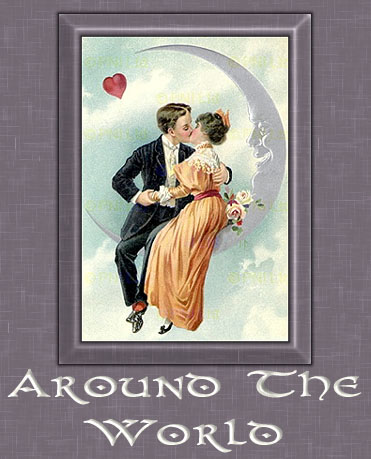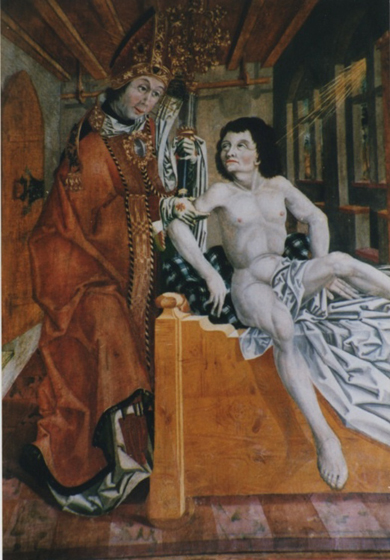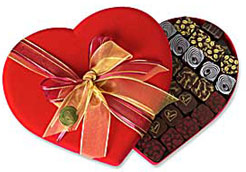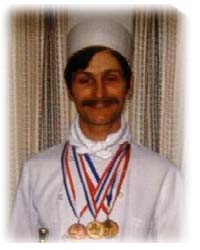The History of Valentines Day
Why do we give Candy and Sweets ?
First A Brief History of How the Valentine Celebration Began
|

Roman Pagan Fertility Celebration.
around 400. BC....... |
The origins of Valentine's Day trace back to the 4th century BC with the ancient Roman celebration of Lupercalia. Held on February 15, Lupercalia honored the gods Lupercus and Faunus, as well as the legendary founders of Rome, Romulus and Remus.
In addition to a bountiful feast, Lupercalia festivities are purported to have included the pairing of young women and men. Men would draw women's names from a box, and each couple would be paired until next year's celebration. This is one theory for the lottery.The Roman emporer Claudius 11 banned marriage because young men wouldn't sign up for the army. He instituted this lottery so a man could have a partner for the yea
More about Lupercalia |
Who was St. Valentines?
It wasn't called "Valentine's Day" until a priest named Valentine came along. Valentine, a romantic at heart, disobeyed Emperor Claudius II's decree that soldiers remain bachelors.Claudius handed down this decree believing that soldiers would be distracted and unable to concentrate on fighting if they were married or engaged.
|
 |
Valentine defied the emperor and secretly performed marriage ceremonies. As a result of his defiance, Valentine was put to death on February 14. After Valentine's death, he was named a saint. As Christianity spread through Rome, the priests moved Lupercalia from February 15 to February 14 and renamed it St. Valentine's Day to honor Saint Valentine |
How did Valentines Cards and the giving of Candy Start? |
 |
Believing that birds began to mate on February 14, people in the Middle Ages started the card tradition by sending love letters on that day.
In the 15th century, singing and spoken valentines were slowly replaced by written letters in Europe. The first written valentine is credited to Charles, the Duke of Orleans, who wrote love poems to his wife while he was in prison in 1415. By the beginning of the 16th century, valentines were almost always written.
Early valentines were hand made on colored paper. Often they were tinted with water colors and inks. Other types of valentines found during this era were:
- Acrostic - the first line of the verses spelled out the recipient's name
- Cutout - the paper was folded and cut into a lace-like design using small, pointed scissors.
- Pinprick - using a pin or needle, tiny holes were punched in the paper to make it look like lace.
- Theorem or Poonah - a stencil was used to help paint on designs that stood for words. For example, the word foot would be replaced by a picture of a foot.
- Puzzle Purse - the paper was a folded puzzle with verses written in the folds. Each verse must be read in a specific order and the puzzle refolded correctly.
- Fraktur - the letters were written in a decorative style to imitate the illuminated manuscripts used in the Middle Ages.The
1800s saw valentines made by factory workers. Black and white pictures were painted by the workers in the early part of the century. By the end of the 1800s, the cards were made by machines. These cards were elaborately decorated with gold leaf, satin, lace and flowers.
In 1840, the first mass produced valentine's cards where made in America. Esther Howland, who sold $5,000 worth of the cards in her first year, created them.
Did You Know?
- In the United States over 1 billion valentine cards are sent each year.
- Valentine's Day is celebrated in the United States, Canada, Mexico, the United Kingdom, France and Australia.
- Parents get 1 out of every 5 valentines.
- Women buy 85% of all valentines.
Valentine Candy
The History of Valentine’s Day
During the 1800’s, doctors commonly suggested that their lovelorn patients eat lots of chocolate to soothe their nerves and calm their emotions.
Chocolate has long been thought to be an aphrodisiac, and as far back as the Aztec empire this delectable creation was used in the pursuit of love.
While we only know the heart shaped candies today, when they were first introduced, these imprinted candies were typically made into such shapes as horseshoes, baseballs, watches and even postcards, and they often sported messages that were far longer than the short and sweet ones we know today.
Conversation Hearts
Approximately eight billion of these candy hearts will be produced in a typical year, enough to stretch from Rome, Italy to Valentine, Arizona and back again some 20 times.
While the peak season for these delicious confections is Valentine’s Day, these candy hearts are produced 11 months out of the year.
The manufacturers of these delicious confections introduce at least 10 new sayings every year, including “Puppy Love” and “Call Home”
Every year the televised quiz show JEOPARDY! Includes a section dedicated to trivia about conversation hearts on its Valentine’s Day program.
Thank you from the Sugarstand Website
About chocolate packaging:
"Initially, chocolate was packed as unwrapped bars in wooden boxes with paper labels, displayed on the shop counter. Individual paper wrappers developed soon afterwards. Gold printing and metal foils repeated the luxury message which gold leaf had given to sweets in earlier centuries. Design used the latest images, and graphics publicized the desirability of chocolate. Even more status was attached to special boxes, decorated with pictures, lined with tissue and paper lace. As the package, not the contents, occupied more and more of the foreground, so advertising has shifted almost entirely from the tast of confectionery towards style by association."
--- Sugar-Plums and Sherbet: The Prehistory of Sweets , Laura Mason [Prospect Books:Devon] 2004 (p. 208)
The Cadbury connection?
"The tradition of giving chocolates on Valentine's Day can be traced to Richard Cadbury, of the English chocolate-making family, who "invented" the first Valentine's Day candy box during the Victorian era. The Victorians, who fancied decorating cards with plump cupids shooting arrows of love, later transferred the image to the lids of heart-shaped boxes filled with dreamy combinations of silken chocolates."
--- For Lovers, Chocolate , Niki Dwyer (UPI), The Buffalo News, February 11, 1998, Lifestyles (p. 2D)
Cadbury itself acknowledges making fancy boxes of chocolates, though it stakes no claims on Valentine's Day:
"Cadbury's 'fancy chocolates' (or assortments) were sold in decorated boxes with small pictures that children could cut out to stick into scrapbooks. Richard Cadbury, who had considerable artistic talents, set out to introduce more ambitious and attractive designs from his own paintings: many of his original boxes still exist. Using his own children as models, or depicting flowers and scenes from holiday journeys, he introduced the first British made fancy chocolate boxes. These proved to be popular, helping both the Cadbury business and the confectionery trade in general. Elaborate chocolate boxes were prized by the late Victorians as special gifts, to be used as trinket or button boxes once the fancy chocolates had been eaten: designs therefore had after-use very much in mind. Designs ranged from superb velvet covered caskets with bevelled mirrors and silk lined jewel boxes, to pretty boxes with pictures of kittens, landscapes or attractive girls on the lid. Their popularity continued until their disappearance during the 1939-45 war: Victorian and Edwardian chocolate boxes are now treasured collectors' items. In the 1870s the quality of the chocolates produced by the company following the introduction of the cocoa press helped Cadbury break the monopoly French producers previously enjoyed in the British market."
SOURCE: Cadbury
| Here are some books I recommend |
These are books I always keep at hand




